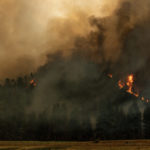Why federal-state partnerships are key to addressing California’s natural disasters and emergencies
Currently, California is grappling with an intense wildfire season, severe drought and a major oil spill. Federal-state partnerships are essential to designing effective and efficient responses to these natural disasters and emergencies. By proactively fostering collaboration, California’s federal and state agencies will be better equipped to collectively address critical situations both now and in the future.
In our issue brief, “The Golden State of Collaboration,” we offer key recommendations for bolstering collaboration across agencies, between levels of government, and with organizations in both the private and nonprofit sectors. To address California’s ongoing climate and environmental crises federal agencies should aim to:
- Foster network building. Host informal gatherings for leaders and subject matter experts that do not necessarily focus on specific projects or goals. Through these convenings, federal and state leaders could develop or strengthen relationships that lay the groundwork effective collaboration. For example, the Federal Emergency Management Agency’s Region IX office hosts convenings with the private sector to better prepare for and respond to disasters. In 2019, FEMA Region IX hosted the Disaster Innovation Forum where attendees discussed how government could work better with the private sector to leverage technology to support those impacted by disasters.
- Convene communities of interest. Gathering cross-sector leaders and experts to share knowledge, resources and perspectives enables agencies to design and implement shared solutions to big challenges. For example, the National Integrated Drought Information System, or NIDIS, is a multi-agency partnership that coordinates drought monitoring, forecasting, planning and information at the federal, tribal, state and local levels across the country. Through region-specific webinars, NIDIS convenes stakeholders to share timely information on current and developing climate conditions like droughts.
- Focus on geography. While working across organizations and sectors is critical, it is also important for stakeholders to navigate a region’s specific challenges and apply resources to address uniquely local issues. For example, to address the wildfires in California, the California Department of Forestry and Fire Prevention recently announced it will direct nearly $138 million in funding to 105 local fire prevention projects that aim to protect communities across the state. In a state where more than half of the forests are under federal control and just 3% of forest land is under the state’s jurisdiction, similar types of collaboration between federal and state agencies is critical to designing targeted responses to California’s increasingly severe wildfire season.
As California’s natural disasters and emergencies continue to increase and intensify, increased coordination between federal and state agencies will be essential. Federal agencies need to be intentional about engaging with state leaders and other stakeholders to help foster collaboration between all levels of government.
To learn more about how organizations can build effective partnerships in California, read our “Golden State of Collaboration” issue brief.”
